Ensuring a positive, productive workplace
As an international center, CIMMYT unites people of various nationalities, cultures, and backgrounds. Sensitivity and respect are key to the way we work. During 3-6 November 2009, El Batán hosted a Dignity Advisors Training workshop that stressed the importance of cross cultural communication and of maintaining a workplace free of harassment and unacceptable behavior.
“A dignity advisor is a trained staff member who is aware of what the different types of inappropriate behavior are and what the appropriate institutional channels are for dealing with them,” said Marco Noordeloos, Gender & Diversity Program (G&D) executive officer. “They are there to listen and help a person who is experiencing harassment decide what to do next.”
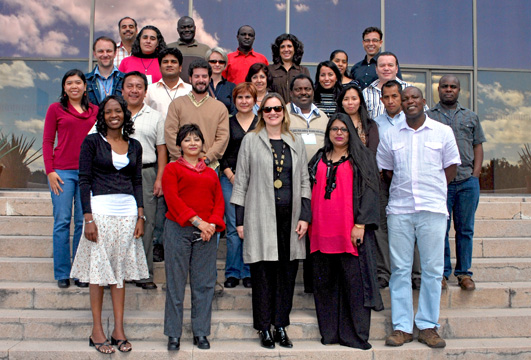 Nearly 30 CIMMYT staff attended the workshop, including members of regional offices in Zimbabwe, Kenya, and Turkey. On the last day of the course, several of the participants took part in a seminar open to all CIMMYT staff. Topics included the four main types of harassment (general, abuse of power, sexual, and discrimination) and why victims often don’t report incidents.
Nearly 30 CIMMYT staff attended the workshop, including members of regional offices in Zimbabwe, Kenya, and Turkey. On the last day of the course, several of the participants took part in a seminar open to all CIMMYT staff. Topics included the four main types of harassment (general, abuse of power, sexual, and discrimination) and why victims often don’t report incidents.
“About 99% of the time, a problem can be fixed by staff development and improving supervisor skills. But the egregious things are never accidents,” said Vicki Wilde, G&D leader. “Neither situation is acceptable. When you sign a CGIAR center contract, you sign up to maintain the highest levels of standard possible; even one person acting poorly can negatively affect an institution and those working for it.”
The Diversity Advisor workshop is one of several offered by the CGIAR’s Gender & Diversity Program. For a decade G&D has been visiting CGIAR centers to “leverage rich staff diversity to increase research and management excellence.” This is the first time G&D has visited CIMMYT in over seven years.
The following colleagues have completed Diversity Advisor training, have an open-door policy, and will maintain confidentiality: Scott Ferguson; Marisa De la O; Manuel Martínez; Paty Villaseñor; Leonor Herradura; Óscar Bañuelos; María Paula De León; Jonalyn Gumafelix; Teresa Rodríguez; Sridhar Bhavani; Petr Kosina; Gerardo Carstens; Pedro Aquino; Víctor Hernández; Ciro Sánchez; Germán Mingramm; Caritina Venado; Fabiola Mendoza; Fred Kanampiu; Sarah Kibera; Dan Makumbi; Seher Turkyilmaz; Julie Nicol; Cosmos Magorokosho; Peter Setimela; Mulugetta Mekuria.
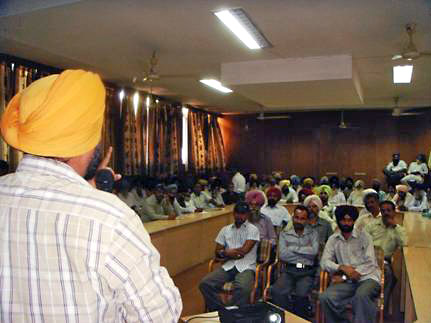 “To save our atmosphere and improve our air quality we must stop the practice of burning residues,” said H.S. Sidhu, Punjab hub manager from CSISA, adding that to increase rice-wheat system yields, at least 50% of straw should be left on the field. With the added biomass, rice yields increase in three to four years, and with only one tractor pass needed, the cost of maintaining wheat fields is reduced USD 100 per hectare. Additionally, the straw maintains soil moisture; suppresses growth of the grass Phalaris minor; minimizes the negative aff ect on yield that high temperatures during wheat maturity cause; and allows a rotation of the short-duration crop saathi moong between the rice and wheat crops.
“To save our atmosphere and improve our air quality we must stop the practice of burning residues,” said H.S. Sidhu, Punjab hub manager from CSISA, adding that to increase rice-wheat system yields, at least 50% of straw should be left on the field. With the added biomass, rice yields increase in three to four years, and with only one tractor pass needed, the cost of maintaining wheat fields is reduced USD 100 per hectare. Additionally, the straw maintains soil moisture; suppresses growth of the grass Phalaris minor; minimizes the negative aff ect on yield that high temperatures during wheat maturity cause; and allows a rotation of the short-duration crop saathi moong between the rice and wheat crops.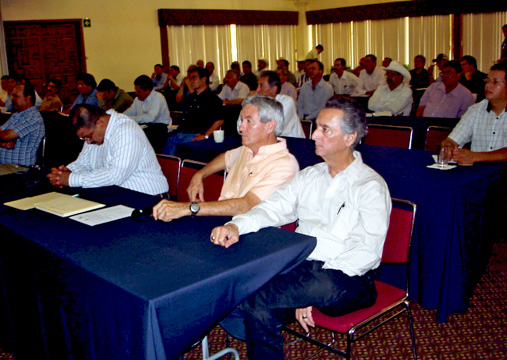 For several years wheat farmers in Sonora State, Mexico, have used infrared sensors to target nitrogen applications more effi ciently. Now, farmers in other major commercial farming regions in Mexico— Guanajuato State, the Mexicali Valley in Baja California, and Sinaloa— also want to experience these savings.
For several years wheat farmers in Sonora State, Mexico, have used infrared sensors to target nitrogen applications more effi ciently. Now, farmers in other major commercial farming regions in Mexico— Guanajuato State, the Mexicali Valley in Baja California, and Sinaloa— also want to experience these savings.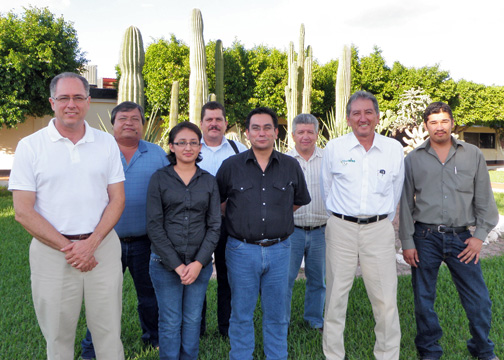 In the last crop cycle, 6,400 hectares of wheat across 271 plots in Sonora were managed using GreenSeeker. Of these 101 were evaluated to show an average savings of 70 kg of nitrogen per hectare, which equaled a monetary savings of US$ 90 per hectare. These plots produced the same yield as those under conventional nitrogen management.
In the last crop cycle, 6,400 hectares of wheat across 271 plots in Sonora were managed using GreenSeeker. Of these 101 were evaluated to show an average savings of 70 kg of nitrogen per hectare, which equaled a monetary savings of US$ 90 per hectare. These plots produced the same yield as those under conventional nitrogen management.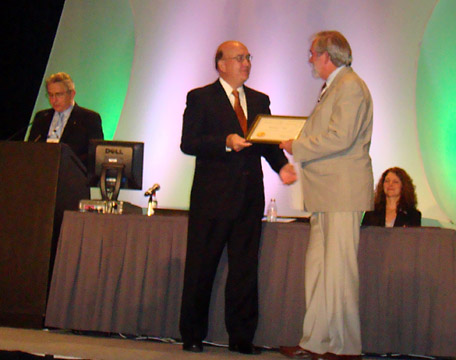 Pat Wall obtains ASA recognition
Pat Wall obtains ASA recognition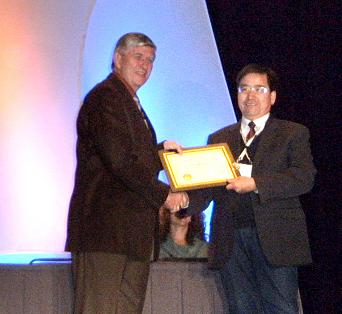 Zhonghu He, principal scientist of CIMMYT’s Global Wheat Program and country representative in China was selected for the 2009 Fellow of Crop Science Society of America (CSSA). The awarding ceremony was held on 3 November during the ASACSSA- SSSA International Annual Meeting in Pitt sburgh. Dr. He made signifi cant contributions in improving Chinese wheat quality, development and application of molecular markers, promotion of international and domestic collaboration, and training. He also received the most prestigious award from Chinese government in 2008 and CGIAR Regional Award in 2007.
Zhonghu He, principal scientist of CIMMYT’s Global Wheat Program and country representative in China was selected for the 2009 Fellow of Crop Science Society of America (CSSA). The awarding ceremony was held on 3 November during the ASACSSA- SSSA International Annual Meeting in Pitt sburgh. Dr. He made signifi cant contributions in improving Chinese wheat quality, development and application of molecular markers, promotion of international and domestic collaboration, and training. He also received the most prestigious award from Chinese government in 2008 and CGIAR Regional Award in 2007.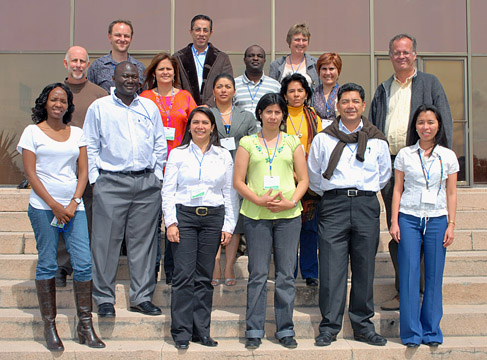 From 29 October to 01 November 2009, 14 mid-level managers from CIMMYT and the International Center for Tropical Agriculture worked intensively on their managerial skills as part of the First Level Leadership Development Program imparted by the global management consulting firm “HayGroup” and hosted by CIMMYT at El Batán. As part of the course, supervisors and selected peers and subordinates were asked to provide feedback on participants’ emotional intelligence, management styles, and other key leadership competencies. The course was co-facilitated by CIMMYT knowledge, information and training manager, Petr Kosina, who said that over 40 CIMMYT staff had already taken the course in the past five years. “Participants of this course value particularly the 360-degree survey, which provides objective feedback on how their colleagues, subordinates, and supervisors see them,” said Kosina. “It’s often only after seeing this feedback that they realize the big influence they have over the creation of a healthy and motivational climate within their work teams.”
From 29 October to 01 November 2009, 14 mid-level managers from CIMMYT and the International Center for Tropical Agriculture worked intensively on their managerial skills as part of the First Level Leadership Development Program imparted by the global management consulting firm “HayGroup” and hosted by CIMMYT at El Batán. As part of the course, supervisors and selected peers and subordinates were asked to provide feedback on participants’ emotional intelligence, management styles, and other key leadership competencies. The course was co-facilitated by CIMMYT knowledge, information and training manager, Petr Kosina, who said that over 40 CIMMYT staff had already taken the course in the past five years. “Participants of this course value particularly the 360-degree survey, which provides objective feedback on how their colleagues, subordinates, and supervisors see them,” said Kosina. “It’s often only after seeing this feedback that they realize the big influence they have over the creation of a healthy and motivational climate within their work teams.”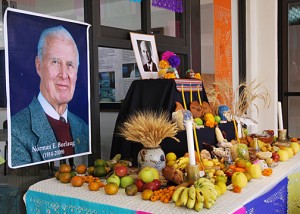 As they have in past years, staff from the Applied Biotechnology Center constructed an altar as part of their Day of the Dead celebration, a traditional Mexican holiday that commiserates the lives of those who have passed. This year the altar was dedicated to Norman Borlaug, the late father of the Green Revolution and important part the CIMMYT family.
As they have in past years, staff from the Applied Biotechnology Center constructed an altar as part of their Day of the Dead celebration, a traditional Mexican holiday that commiserates the lives of those who have passed. This year the altar was dedicated to Norman Borlaug, the late father of the Green Revolution and important part the CIMMYT family.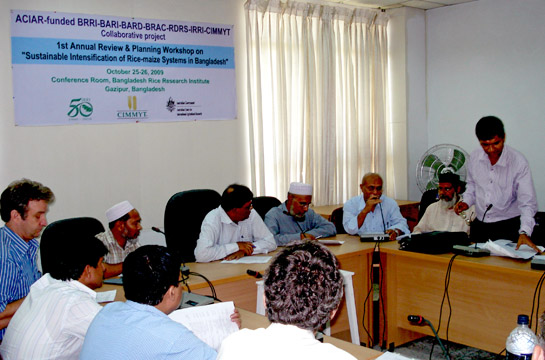 Partners of the “Sustainable intensification of rice-maize production systems in Bangladesh” met 25-29 October 2009 for the project’s first annual review—the program started in June 2008 and will run until 2013. Nearly 50 people attended the meeting held at the Bangladesh Rice Research Institute (BRRI) in Gazipur, Bangladesh. The Australian Center for International Agricultural Research (ACIAR) funds the project, which focuses on research and technology delivery for conservation agriculture (CA) and site-specific nutrient management (SSNM).
Partners of the “Sustainable intensification of rice-maize production systems in Bangladesh” met 25-29 October 2009 for the project’s first annual review—the program started in June 2008 and will run until 2013. Nearly 50 people attended the meeting held at the Bangladesh Rice Research Institute (BRRI) in Gazipur, Bangladesh. The Australian Center for International Agricultural Research (ACIAR) funds the project, which focuses on research and technology delivery for conservation agriculture (CA) and site-specific nutrient management (SSNM).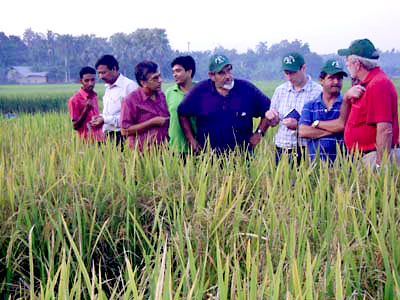 The last three days of activities took place in the research stations of BARI, BRRI, and the Bangladesh Academy for Rural Development (BARD), as well as at on-farm sites in Rajshahi and Comilla. Scientists spoke with farmers about the benefits of CA technologies and received feedback from the farmers about the different technologies tested in their fields as well as overall project activities. First year CA activities for maize primarily focused on seeding on flat land with a power tiller operated seeder (PTOS) and seeding with a bed former/planter on raised beds under reduced tillage. For rice, emphasis has been on direct-seeded rice with the PTOS, direct-seeded rice using a bed former/planter, and transplanting seedlings on raised beds.
The last three days of activities took place in the research stations of BARI, BRRI, and the Bangladesh Academy for Rural Development (BARD), as well as at on-farm sites in Rajshahi and Comilla. Scientists spoke with farmers about the benefits of CA technologies and received feedback from the farmers about the different technologies tested in their fields as well as overall project activities. First year CA activities for maize primarily focused on seeding on flat land with a power tiller operated seeder (PTOS) and seeding with a bed former/planter on raised beds under reduced tillage. For rice, emphasis has been on direct-seeded rice with the PTOS, direct-seeded rice using a bed former/planter, and transplanting seedlings on raised beds.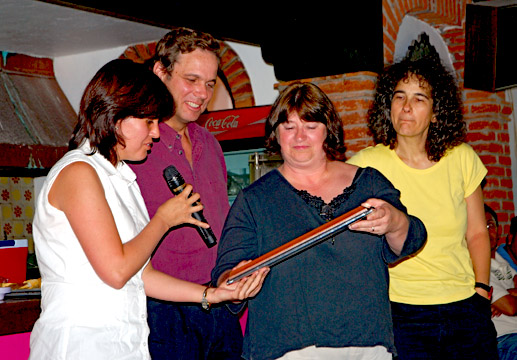 Coworkers, family, and friends gathered on 23 October 2009 in El Batán’s Rincón Mexicano to say goodbye to Kevin Pixley, former associate director of the Global Maize Program (GMP), who will start work at the University of Wisconsin in November. He will remain involved with CIMMYT activities as a partnered scientist and will dedicate 50% of his time to HarvestPlus, an international, interdisciplinary program to alleviate nutritional deficiency through breeding micronutrient-enriched staple foods.
Coworkers, family, and friends gathered on 23 October 2009 in El Batán’s Rincón Mexicano to say goodbye to Kevin Pixley, former associate director of the Global Maize Program (GMP), who will start work at the University of Wisconsin in November. He will remain involved with CIMMYT activities as a partnered scientist and will dedicate 50% of his time to HarvestPlus, an international, interdisciplinary program to alleviate nutritional deficiency through breeding micronutrient-enriched staple foods.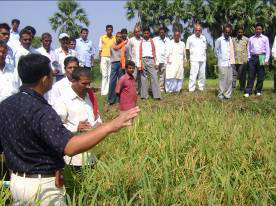 Three years of sowing experience with conservation agriculture (CA) practices in a rice-wheat system at an agricultural outreach station (KVK) in the Jamui district of Bihar State in India have been successful. So far, results show that dry, direct-seeded rice or transplanted rice on permanent beds give higher yields than other crop establishment methods, said KVK agronomist P.K. Singh to visitors during a CA farmer’s field day.
Three years of sowing experience with conservation agriculture (CA) practices in a rice-wheat system at an agricultural outreach station (KVK) in the Jamui district of Bihar State in India have been successful. So far, results show that dry, direct-seeded rice or transplanted rice on permanent beds give higher yields than other crop establishment methods, said KVK agronomist P.K. Singh to visitors during a CA farmer’s field day.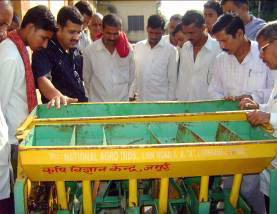 Later in the day, farmers viewed various plots sown with different CA practices, during which they asked questions and saw CA machinery demonstrations. Dry, direct-seeded rice with anchored residues in a permanent no-till system caught the attention of many participants, along with the high-yielding, unpuddled transplanted rice on permanent beds. Farmers also discussed weed management practices for various crops with Ravi Gopal, agronomist for the Cereal Systems Initiative for South Asia (CSISA). The event was part of CSISA’s delivery objective for the central Bihar Hub.
Later in the day, farmers viewed various plots sown with different CA practices, during which they asked questions and saw CA machinery demonstrations. Dry, direct-seeded rice with anchored residues in a permanent no-till system caught the attention of many participants, along with the high-yielding, unpuddled transplanted rice on permanent beds. Farmers also discussed weed management practices for various crops with Ravi Gopal, agronomist for the Cereal Systems Initiative for South Asia (CSISA). The event was part of CSISA’s delivery objective for the central Bihar Hub.